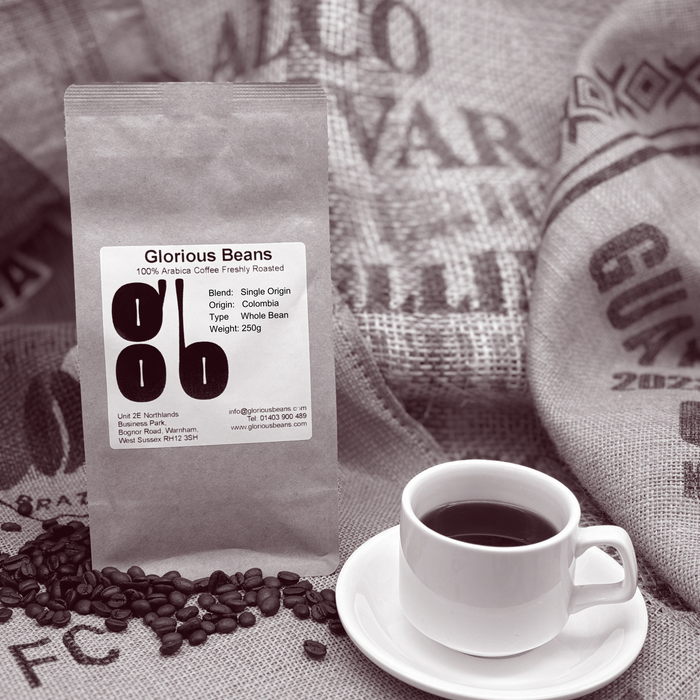Recognizing Coffee Beans: the Journey From Espresso to Blended Coffee Beans

The Origins of Coffee: An International Perspective
While you might assume of coffee as a modern staple, its origins map back centuries, linking with societies across the globe. The tale begins in Ethiopia, where legend states a goat herdsman called Kaldi discovered the stimulating effects of coffee beans after noticing his goats frolicking energetically after eating them.
As profession courses expanded, coffee made its method to Europe in the 17th century, quickly acquiring popularity. It transformed from a mystical drink right into a daily routine, inspiring celebrations and intellectual exchanges. Each culture included its special spin to coffee preparation, enhancing its history. This international trip highlights how coffee connects us, transcending boundaries and unifying varied traditions through a straightforward bean.
Growing and Harvesting of Espresso Beans
As coffee's journey advanced, the focus moved to the growing and harvesting of specific bean ranges, especially those utilized for espresso. You'll discover that coffee beans often originate from Arabica or Robusta plants, each offering distinctive tastes. The excellent growing conditions include high elevations and abundant, well-drained soil, which enhance the beans' high quality.
Throughout the harvest, choosing techniques vary. In some areas, employees hand-pick ripe cherries, guaranteeing only the very best fruit goes to handling. In other areas, mechanical farmers are utilized, especially on bigger farms. When the cherries get to peak ripeness for optimum flavor., timing is important; you desire to gather.
As soon as gathered, the beans are prepared for processing, which is necessary in identifying their final preference. Understanding the farming and harvesting procedures provides you understanding into what enters into your preferred espresso, enhancing your recognition for each mug.
Processing Approaches: From Cherry to Bean
Since you have actually learned concerning gathering coffee beans, let's discover how those cherries transform right into the coffee beans you enjoy. You'll see exactly how various harvesting techniques effect flavor, adhered to by the necessary steps of fermentation and drying. We'll damage down the milling and grading procedure that determines your coffee's top quality.
Gathering Strategies Clarified
When it comes to coffee, understanding harvesting techniques is vital, considering that they straight affect the flavor and high quality of the beans you appreciate. Discerning selecting entails hand-picking just ripe cherries, ensuring you get the best quality beans. Ultimately, the choice of collecting strategy can substantially affect your coffee experience, so it's worth recognizing just how those beans made it to your cup.
Fermentation and Drying
After harvesting, the following action in handling coffee beans play a considerable function fit their taste. You'll discover that fermentation is essential, as it aids break down the mucilage surrounding the beans, boosting their taste profile. Depending on the method, this procedure can last from a few hours to numerous days, with differing results based on temperature level and moisture.
Once fermentation is full, drying out follows, which is just as vital. You can pick from sun-drying or mechanical drying out techniques. Sun-drying allows the beans to soak up tastes from the environment, while mechanical drying out guarantees regular dampness levels despite weather condition. Proper drying out is necessary to protect against mold and maintain the beans' high quality, inevitably influencing your mug of coffee.
Milling and Grading Refine
As fermentation and drying established the stage for taste development, the milling and grading process warranties that only the most effective coffee beans make it to your mug. This stage includes getting rid of the outer layers of the coffee cherry, including the parchment and husk. After milling, the beans are arranged by dimension and weight, guaranteeing a consistent quality. You'll locate that grading helps identify flaws and classify beans, which affects flavor and scent. High-quality beans get a higher quality, resulting in a richer coffee experience. Once graded, the beans await packaging and delivery, maintaining their unique qualities. This careful procedure is important for providing the exceptional taste you enjoy in every sip of your favorite brew.
Toasting Strategies: Opening Taste Possible
When you roast coffee beans, the technique you select can dramatically affect the flavor profile. Understanding the relationship between time, temperature level, and toasting strategies is vital to exposing the capacity of your brew. Let's check out exactly how these aspects collaborated to create the excellent mug.
Toasting Approaches Clarified
While you might believe that all coffee toasting techniques generate the same results, the fact is that each method discloses distinct taste capacities in the beans. Drum toasting uses a turning drum to equally distribute warm, boosting caramelization and creating a well balanced taste. Air roasting, on the other hand, distributes warm air around the beans, promoting a lighter roast with obvious acidity.

Effect On Flavor Profile
Various toasting methods not just influence the process however additionally considerably influence the flavor profile of the coffee beans. When you choose a light roast, you'll experience bright acidity and floral notes, showcasing the bean's beginning. In comparison, a tool roast balances acidity with sweetness, frequently disclosing chocolatey undertones. Dark roasts, on the other hand, bring out strong, great smoky tastes, often covering up the bean's unique qualities. Each method discloses various oils and substances, resulting in a large array of tastes. By trying out numerous roasting styles, you can find which profiles resonate with your palate. Comprehending these subtleties assists you value the artistry behind your cup of coffee, enhancing your overall experience with every sip.
Time and Temperature Level Elements
To launch the full flavor potential of coffee beans, both time and temperature level throughout the roasting procedure play substantial functions. When roasting, you'll locate that greater temperatures can rapidly develop flavors, but if you hurry it, you may end up with burnt notes. Conversely, reduced temperature levels permit a much more gradual taste growth, showcasing the beans' special qualities.

Timing is simply as crucial; extending the roast also long can cause a loss of acidity and brightness, while also short a roast could leave the beans underdeveloped. Locating that wonderful place check my reference requires technique and testing. By readjusting these variables, you can expose the abundant, complex tastes concealed within each bean, creating an absolutely exceptional coffee experience.
The Art of Blending: Crafting Distinct Coffee Accounts

Start by selecting a base coffee that offers a solid foundation. Select corresponding beans to boost details flavor notes. A brilliant Ethiopian bean can bring fruitiness, while a rich Brazilian coffee adds body. Testing is crucial-- don't hesitate to change ratios up until you find your suitable account.
As you mix, remember that each mix informs a tale. You're not simply making coffee; you're producing an experience. Take your time, taste regularly, and appreciate the trip of uncovering your trademark mix - Single Origin Espresso.
Developing Techniques: Exactly How Prep Work Influences Taste
Mixing coffee opens up a domain of taste opportunities, yet just how you brew that mix can significantly affect your last cup. On the other hand, a pour-over highlights the coffee's clarity and brightness, ideal for showcasing fragile notes.
Espresso, with its high stress, produces a concentrated shot that highlights sweet taste and crema. If you choose a lighter mixture, think about a cool brew approach; it generates a smooth, much less acidic taste.
Inevitably, testing is vital. Changing variables like water temperature level, grind size, and make time can change your coffee's profile. So, accept the art of developing to discover the flavors hidden in your coffee blends. The right technique can raise your experience to brand-new heights.
The Future of Coffee: Sustainability and Technology
As the coffee industry progresses, sustainability and technology are becoming crucial for dealing with ecological obstacles and conference consumer demands. You'll discover that more coffee business are embracing green methods, from sourcing beans morally to implementing sustainable farming techniques. These shifts not only assist the world yet also enhance the quality of the coffee you delight in.
You may see technologies like biodegradable packaging and water-saving brewing techniques that decrease waste. Advanced innovation, such as blockchain, is likewise ending up being prominent, making sure openness in the supply chain, which enables you to trace your coffee back to its origins.
Furthermore, buying local communities and sustaining farmers with fair trade initiatives fosters an extra lasting coffee ecosystem. As you sip your following mug, bear in mind that your visite site options can add to a brighter future for coffee. By going with sustainable brands, you're not just enjoying a drink; you're making a favorable effect on the world.
Regularly Asked Inquiries
What Is the Distinction Between Arabica and Robusta Beans?
Arabica beans are smoother, sweeter, and have a greater level of acidity, while robusta beans are stronger, extra bitter, and consist of more high levels of caffeine. When brewing your coffee., you'll notice these distinctions in taste and scent.
How Does Elevation Affect Coffee Bean Taste?
Elevation impacts coffee bean flavor considerably. Greater altitudes create beans with brighter level of acidity and facility flavors, while reduced altitudes commonly yield beans that are larger and less nuanced. You'll observe these differences in your mug!
What Are the Health Perks of Alcohol Consumption Coffee?
Consuming coffee can enhance your energy, enhance psychological emphasis, and even improve physical efficiency. It's rich in antioxidants, might lower the danger of certain diseases, and can advertise a much healthier metabolism when consumed in small amounts.
Can Coffee Beans Be Reused for Brewing?
Yes, you can reuse coffee beans for brewing, however the taste could be weak. If you enjoy exploring, attempt recycling them in various ways, like cold brews or including to smoothies for an additional kick.
Exactly how Should I Shop Coffee Beans for Quality?
To maintain your coffee beans fresh, save them in an airtight container in a great, dark area. Avoid exposing them to light, heat, or moisture, as why not try these out these factors can rapidly deteriorate their flavor and scent.
Recognizing Coffee Beans: the Trip From Coffee to Blended Coffee Beans.
Currently that you have actually found out about harvesting coffee beans, allow's discover how those cherries transform into the coffee beans you love.When you roast coffee beans, the method you choose can substantially influence the taste account - Single Origin Espresso.While you might think that all coffee toasting approaches generate the exact same results, the reality is that each method exposes special flavor capacities in the beans.Different roasting techniques not only influence the process but also significantly affect the flavor account of the coffee beans